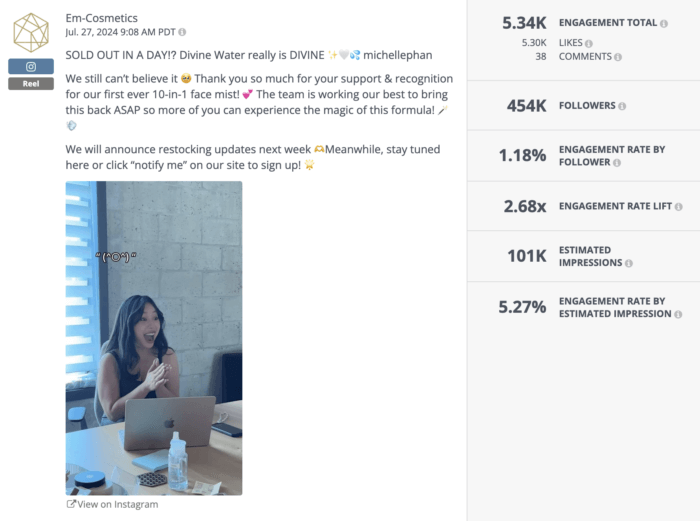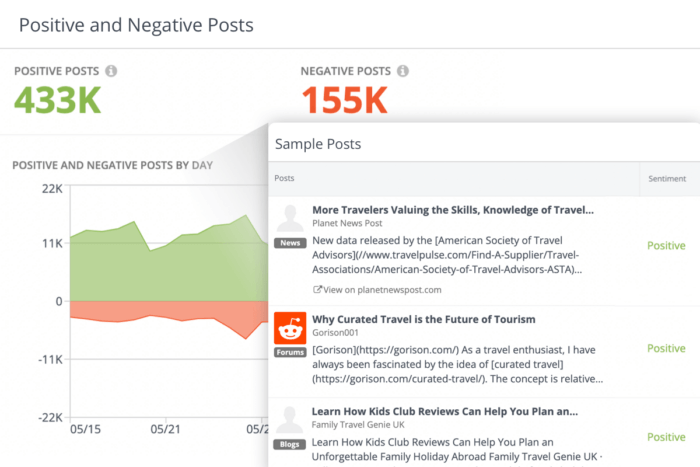Picture yourself scrolling through social media and coming across a negative review that’s been seen and shared by thousands. For brands, this is the stuff of nightmares — but it’s also a very real scenario that can happen to any business. One bad experience can rapidly spiral into a viral problem.
So, how do you keep your brand’s image intact when everyone online has an opinion and a platform? By actively managing your social media reputation. Stick around as we break down what social media reputation management is, why it matters, and what this approach involves.
Social Media Reputation Management: Explained
Social media reputation management — or SMRM, for short — is the practice of monitoring, influencing, and managing how your brand is seen on social media. It’s a proactive strategy that involves tracking mentions, responding to reviews, and engaging with your audience to shape a positive image online.
Unlike old-school reputation management, which often focuses on offline strategies like press releases or making nice with the media, SMRM zeroes in on real-time, online interactions. It’s about staying ahead of potential PR crises by quickly addressing negative comments or misinformation while also amplifying positive online interactions and feedback.
With social media reputation management, you’re not just playing defense; you’re going on the offensive to build a strong and positive reputation. A smart SMRM strategy has you shaping how people see your brand, making sure every interaction aligns with your values and tells your story the way you want it told.
Why Social Media Reputation Management Matters
There’s no denying that social media has become a powerful force in shaping brand perception. With instant access to reviews, comments, and posts, people can quickly form opinions about your brand based on what they see online. And these opinions? They directly impact your bottom line. Here’s why keeping a close eye on your social media presence is crucial.
Boost Customer Trust and Loyalty
Actively managing your online reputation shows that you genuinely care about your customer’s feedback and are dedicated to resolving any issues they might have. This level of transparency not only builds trust but also helps you earn brand loyalty.
A perfect example of this in action is Spotify Cares, the customer service arm of Spotify on social media. They’re highly responsive on both Twitter and Facebook, where they handle a wide range of questions, complaints, and concerns.
Take this real example of an X user wondering whether their Spotify can get hacked:

The interaction shows how Spotify actively monitors conversations about its brand (even when not directly tagged!) and immediately steps in to assist. This kind of responsiveness not only solves problems quickly but also reassures other users that Spotify takes its customers seriously. Given that 63% of consumers say that social media customer service quality significantly influences their brand loyalty, Spotify is clearly doing things right.
Improve Crisis Management and Damage Control
Building trust and loyalty with your customers is crucial, but what happens when a crisis hits? That’s when staying on top of your social media mentions becomes invaluable. A swift and transparent response not only helps you manage the situation but also minimizes potential damage to your reputation.
The stats are clear: 76% of consumers value how quickly a brand responds to their needs, and nearly 70% expect a response within 24 hours or less. By actively monitoring social media conversations and reacting swiftly, you solve problems efficiently while also reinforcing your commitment to customer satisfaction.
Strengthen Brand Image and Credibility
A strong online reputation isn’t just handed to you — it’s earned through consistent, effective management of your brand’s presence. When you nail this, you’re seen as reliable, professional, and, most importantly, authentic.
In fact, 65% of consumers feel more connected to brands with a robust social media presence. Interestingly, when a CEO is actively involved on social media, 70% of consumers feel a stronger connection to that brand, with nearly two-thirds saying it feels like real people are running the show, making the brand feel more genuine and credible.
Take Em Cosmetics, for example. They nailed it with a recent Instagram post where the founder and team celebrated a product sell-out with genuine appreciation and a restocking update. This authentic moment not only resonated with their audience but also earned an impressive engagement rate of 1.18% — more than 8x higher than the average engagement rate for beauty brands on Instagram (0.14%).

Ultimately, by embracing social media as a platform for real, human connection, you not only stand out but also reinforce your brand’s credibility. After all, in a world where consumers crave authenticity, showing the human side of your brand can be your greatest asset.
Drive Customer Engagement and Interaction
Social media is all about connections and conversations, and when you actively participate, you’re not just joining the dialogue — you’re driving it. Engaging thoughtfully with your audience invites more meaningful interactions and strengthens your connection with them.
According to a study from Sprout Social about the power of social media, 91% of people still believe in social media’s power to bring people together and 78% of consumers want brands to use social media to help people connect with each other. So, why not be the brand that leads the charge? Go beyond simply responding to complaints by building a brand community.
For instance, Wendy’s social media strategy is a textbook case in how to drive engagement. Their clever replies and humorous tweets created a buzz that not only delighted their followers but also kept them engaged. With 55% of consumers saying that liking or responding to their comments helps them feel more connected to a brand, it’s no wonder Wendy’s social strategy has been such a hit.
Find out what is a good engagement rate on social media. 
The High Cost of Ignoring Your Social Media Reputation
Neglecting your online reputation can spell disaster for your brand. When trust starts to slip away, it’s not just about losing one customer; it impacts how everyone perceives your brand.
Think of it like this: when negative reviews, false information, or customer complaints are left unchecked, they start to chip away at your brand’s credibility. As trust erodes, customers are more likely to jump ship, especially if they feel their concerns are being brushed aside.
A tarnished brand image can also have a direct negative impact on sales. Research shows that 92.4% of consumers use online reviews to guide most of their ordinary purchasing decisions. In other words, a bad reputation doesn’t just hurt today’s sales but also future opportunities. Negative word-of-mouth can deter potential customers before they even get a chance to experience what you offer.
The toughest part? Once your reputation takes a hit, recovering can be a long and grueling process. Brands that neglect their online presence can find themselves stuck in a cycle of damage control, struggling to rebuild trust and reclaim their standing. It’s a tough road, but one you can avoid by staying proactive and engaged with your social media reputation.
4 Key Elements of Social Media Reputation Management
To keep your brand’s online presence in top shape, you need a solid plan. Here are four essential components to managing your social media reputation like a pro.
1. Tune Into Social Listening
Social listening is the backbone of effective social media reputation management and involves actively monitoring online platforms to see what people are saying about your brand, industry, and competitors.
By staying in tune with the conversations happening online, you can pick up valuable insights on how your brand is perceived, spot potential issues before they blow up, and find opportunities to boost your brand’s image.
There are plenty of social listening platforms out there that make this easy. For instance, our platform, Rival IQ, includes handy features for tracking mentions, keywords, and hashtags that matter to your brand. Plus, with sentiment analysis, you can quickly see whether the conversations around your brand are positive, neutral, or negative.

By setting up keyword alerts and regularly checking your brand mentions across platforms, you’ll stay in the loop on what’s being said about your brand and industry. This also opens the door to you joining trending topics that are relevant to your audience.
Whether you want to celebrate a win, address a concern, or share the spotlight with a pop culture moment, social listening will help you jump in and steer the conversation in the right direction.
2. Engage and Respond
Of course, it’s not enough to simply listen; you need to actively participate in conversations to build a positive image and foster trust. This means more than just posting content. You want to interact with your followers, answer their questions, and acknowledge their feedback.
One of the best practices for interacting with your audience is to be prompt and genuine. Responding quickly and earnestly to comments shows that you care about your customers’ experiences. Got a negative comment? Stay cool, offer an apology if needed, and provide a solution. Your calm and constructive approach can turn a critic into a loyal supporter.
On the flip side, don’t forget to engage with positive feedback as well. Acknowledge and thank your followers for their support, share user-generated content, and keep the conversation going with interactive elements like questions or polls.
Remember, every interaction is an opportunity to reinforce your brand’s values and build trust with your audience. By actively engaging with your audience, you encourage a sense of community and loyalty and strengthen your reputation over time.
3. Invest in a Solid Content Strategy
A well-crafted content strategy is vital for shaping and maintaining your social media reputation. The content you create and share not only defines your brand but also influences how the world sees you.
So, what makes a content marketing strategy shine? Whether it’s showcasing your expertise, sharing valuable insights, or simply entertaining your followers, make sure your content adds value.
The content you share should not only reflect your brand’s identity but also resonate with your audience and showcase your expertise. You can also spotlight user-generated content and testimonials — they’re powerful tools for highlighting customer satisfaction and reinforcing positive perceptions.
Finally, be sure to be consistent. Keep your content calendar updated and stick to a regular posting schedule. This not only keeps your audience engaged but also strengthens your brand’s presence over time.
4. Monitor and Analyze
As with any effort, keeping an eye on your performance is essential to staying dynamic and ahead of the game. Regular monitoring keeps you updated on what’s happening, while analytics go a step further, revealing the true impact of your social media efforts.
Only by analyzing key social media metrics like engagement rate, reach, follower growth, sentiment, and share of voice can you learn what’s working and what needs improvement. For example, if you notice a spike in negative sentiment following a particular campaign, you can investigate the cause and take corrective action. On the other hand, when something clicks and your audience responds positively, you’ll know to double down on those winning strategies.

So how do you access all this valuable data? Well, you’ve got options. Most social media platforms offer native analytics tools that give you the low-down on your performance, reporting plenty of data about your followers, content performance, and more.
However, hopping between platforms can be a hassle. That’s where social media analytics tools come in handy. They consolidate data from all your accounts into one place, making it easy to see the big picture.

Free social media competitive analysis template
Download nowOur platform gives you a comprehensive view of your social media landscape, helping you identify problem areas and spot opportunities. In addition to analyzing your social media posts, we also make it easy to see how you stack up against the competition. Understanding what your competitors are doing well — and where they’re slipping up — can give you a massive advantage in managing your reputation.
In short, don’t just post and hope for the best. Monitor and analyze your efforts so you can make informed decisions that drive your brand forward.
The Wrap Up
Social media will continue to shape public perception for years to come, which means actively managing your reputation isn’t just a nice-to-have — it’s essential for long-term success. A strong reputation is one of your most valuable assets. Take the time to manage it well, and it’ll pay off in no time.
